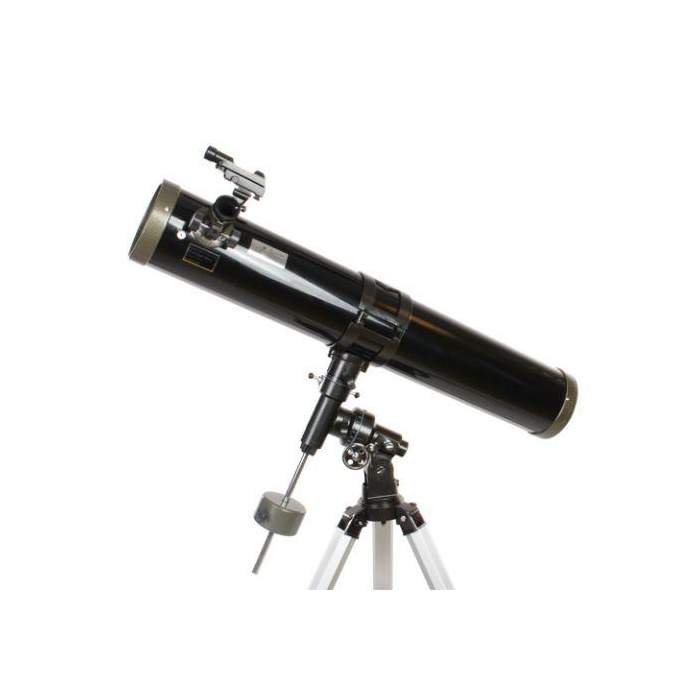
The Byomic Galaxydiver EQ-SKY 114/900 is the perfect telescope for experienced and advanced astronomers. Since the Byomic Galaxydiver is equipped with a 114 mm Newtonian mirror and has a focal length of 900 mm, it is not only suitable for observing the moon and planets, but also for observing deep-sky objects such as gas nebulae, star clusters and galaxies.
Application Byomic reflector telescope Galaxydiver 114/900 EQ-SKY
With the Byomic Galaxydiver, you have a reflecting telescope that is ideally suited for astronomical observations. If you still want to make terrestrial observations, you should use an inverter prism. This will mirror the image and you will see the objects as you would normally see them. If you are observing celestial objects, this mirror image will not bother you. With the included inverter prism, you also get an additional magnification of 1.5x.
Equatorial port
The Byomic Galaxydiver EQ-SKY 114/900 is equipped with an equatorial mount that allows you to easily move with the celestial bodies while observing. You point the vertical axis at Polaris, then you can follow the celestial bodies with the horizontal axis. To keep the telescope balanced, an equatorial mount always comes with a counterweight.
A great advantage of an equatorial mount is that objects can be observed for a long time without having to look for them every time because the earth is rotating. The scope of delivery of the equatorial mount also includes two fine adjusters that can be used to position the telescope even better when looking through the telescope.
Ocular
The telescope comes with three eyepieces, one with a focal length of 20 mm, one with 15 mm and one with 10 mm. This allows you to achieve magnifications of 45x, 60x and 90x respectively.
When using the supplied Barlow lens, you can increase the magnification by a further 2x and even achieve magnifications of 180x.
With a Barlow lens, the effective focal length is extended, resulting in higher magnification. The image becomes sharper, making it interesting to take photos of your observation with a Byomic smartphone adapter. (See optional accessories). In addition, using a Barlow lens is very simple. You insert the eyepiece into the Barlow lens, then insert the whole thing into the telescope.
It is advisable to start with a small magnification and then extend it. If you start with a large magnification (10 mm eyepiece), the results will usually not be satisfactory.
When an eyepiece with a large focal point and therefore low magnification is used, the eye captures more light, giving a clearer image than when a large magnification with a smaller focal point is used.
Red dot viewfinder
The Red Dot Finder makes it easy to point the telescope at a celestial object. If you look through the Red Dot Finder and move the telescope so that the red dot is visible on a celestial object, you will see this when looking through the eyepiece.
| Spotting Scope | Tele Scopes |
- 1. Evaluate your options.
- 2a. If you want to buy only one product with Aizdevums.lv leasing, then fill out the application here
- 2b. If you want to buy several items or use another leasing company, then put the items in the basket and choose the leasing service when ordering.
We offer leasing from Aizdevums SIA, Incredit SIA, ESTO.
Manager will check the availability of the items in the cart and send the loan application link. - 3. If you receive a positive response, contact us to purchase the product. Consultants will check the availability of the product.
- 4. If the product is available in the store or to be ordered from the warehouse, and you have received an affirmative answer from our consultants, please visit the store to proceed with purchase and leasing documents.
- 4a. You can also ask us to issue an invoice for this product and visit one of the leasing company branches to sign up leasing documents *..
- 5. Once the leasing documents have been signed up, you can receive the product in the store, if it is on site or inform our consultants and they will order it for you from the warehouse.
- *It is possible to arrange delivery for leased goods, so you can also perform the entire purchase process remotely.
**The sequence of leasing steps is the same for leases offered by InCredit Group.
***In case of doubt, contact our consultants!
When using leasing services, carefully evaluate your options to repay the loan!Lease
 Google
Google















